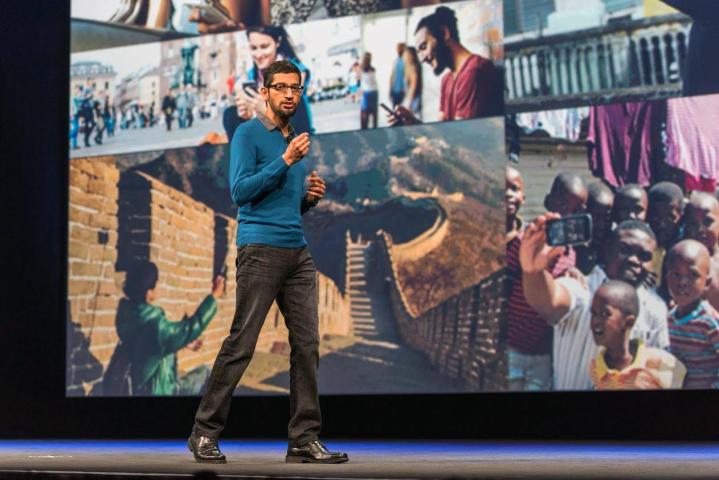

Scanning the #IO15 hashtag on Twitter reveals other people didn’t enjoy the two-and-a-half hour show much either. “IO15 was a major letdown,” says @shifrerm, and @White_Fitzah says it was “a little underwhelming.” User @Auuttumn doesn’t mince words, and states it was “The dullest IO15 ever.” We think he means it was the dullest Google I/O ever, as we’re only aware of one I/O planned for this year.
So the masses have spoken. Except they’re completely wrong. Google went global with I/O this year, and although we didn’t get much cool new tech over which to fawn, we did get to see how other parts of the world are really starting to benefit from Android and smartphones in general. You know what? It was a damn sight more exciting and life-changing than oohh-ing and ahhh-ing over another Android Wear smartwatch we probably won’t buy.
Google’s thinking about the next billion
You really should have seen it coming. Google’s Sundar Pichai made it all very clear right at the start of the show, by virtually dropping in on those gathered in Mexico City, and Nairobi, Kenya to watch the live stream. He then told us 600 million people in the last year have started using a smartphone for the first time — and it wasn’t just their introduction to phones, but to computing and the Internet in general. That’s an astonishing number.
Google I/O went global this year, and it was way better than seeing skydivers, a stupid Chromebook, or any other gadget.
We need to stop thinking about Android being installed on the high-end smartphones many of us buy without a second thought. Android is about the difference it’s making in parts of the world where a smartphone is the only connection to the Internet. It’s about places where data connections are expensive, and slow, and networks are often blighted by poor coverage — where you need two SIM cards in a phone because only one network works near your home, and the other provides free calls after 6pm to your friend who lives in another town. Not because you’re traveling the world for six months and need to post to Instagram.
Google’s Jen Fitzpatrick, VP of Engineering, explained how smartphones are truly changing lives. It was inspiring stuff, because Google’s adapting something that we see optimized for mega-networks on mega-phones, for a similar experience on not so mega equipment, in places where a Galaxy S6 is prohibitively expensive.
It all starts with the little things like making Web browsing less data intensive and faster, bringing YouTube and Google Maps offline, and enhancing hyper-local business discovery. Then goes all the way up to the beautiful madness of Project Loon, which is now at a stage where just one of those crazy balloons can provide Internet connectivity to an area the size of Rhode Island, and with the stability and speed to happily stream YouTube videos. They can even be linked together. Doesn’t matter much to me personally, but in places where network infrastructure is impossible to install, it’s a huge deal.

Still think it’s not important? How about this: an incredible 1.2 billion smartphones will be sold over the next two years alone in six developing markets, including India, Brazil, and Indonesia. That’s where Android One comes in, providing high quality, locally relevant hardware at realistic prices, with software that remains up to date.
Phew, all this must have set the #IO15 hashtag alight, right? Wrong. There’s barely a mention about any of it. How sad. I’m assuming everyone was too moved by the video showing the amazing smartphone-fueled growth of konga.com in Africa, and the Brazilian-developed Livox app, which gives a voice to those who cannot speak due to a disability. Oh wait, nope. Didn’t hear much about those either.
Remember how exciting your first phone was?
My very first smartphone was the original HTC Touch, and I loved it. I still own it, actually. I think back to how it made me feel, and the things it could do. It was life changing. I can only imagine how someone must feel about their first phone today — particularly one so advanced as an Android One device, or something like a Galaxy Ace.
Lives are improving because of the devices we love, and it’s truly exciting.
We shouldn’t be lamenting the fact a new Nexus wasn’t announced at Google I/O; we should be rejoicing that people who previously didn’t have access to a smartphone at all are getting ever-improving access to the services, hardware, and features we’re so passionate about. Lives are improving because of the devices we love, in a way that many of us simply can’t understand; and it’s truly exciting. Millions more people are about to enjoy the amazing mobile tech we have been using everyday for years.
The next billion people to connect up are going to shape the way mobile software is developed, the features it contains, and the hardware on which it’s installed in a major way over the coming years, so we best pay attention. From the Android One platform, to improved offline modes, Google Translate, Project Loon, and the Android Development Nanodegree course, Google is looking at the big picture. Google I/O went global this year, and it was way better than seeing skydivers, a stupid Chromebook, or any other gadget that’ll end up only being relevant to a tiny proportion of the world’s population for five minutes.
What Google’s working on is going to impact people for years.

